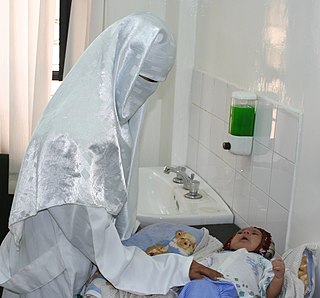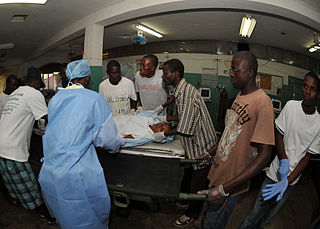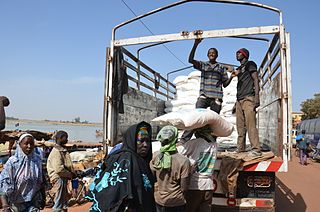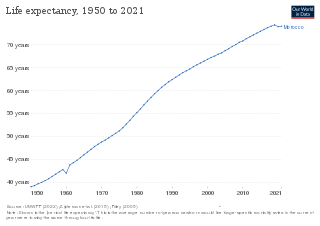This article needs to be updated.(November 2010) |
This article needs to be updated.(November 2010) |
Mauritania's health care infrastructure in the early 1980s consisted of a central hospital in Nouakchott, twelve regional hospitals, a number of health clinics, maternal and child care centers, dispensaries, and mobile medical units to serve the countryside. All facilities suffered from a lack of equipment, supplies, and trained personnel. The ratio of people to hospital beds was 2,610 to one. The ratio of people to physicians was 13,350 to one. This ratio represented an improvement over the 1965 figure of 36,580 to one and was better than that of some of Mauritania's neighbors. [1]
In 1987 Mauritania's largest medical facility was the 500-bed government-run hospital in Nouakchott. Staffed by Mauritanian and expatriate doctors, it lacked supplies and properly maintained equipment. Other facilities included the National Health Center, built in 1977 for the study of disease prevention and methods of public health care education, and the National School of Nurses and Midwives, founded in 1966 to train nurses, midwives, and paramedical personnel. [1]
In general, health standards were quite low, and many infectious diseases were endemic. Contagious diseases (such as measles and tuberculosis) and respiratory disorders were more prevalent in northern arid regions, whereas malaria, guinea worm infection, and schistosomiasis were more common in the Senegal River Valley. The desert tended to be a healthier environment than the more tropical south, but several major diseases were common to all areas of the country. Typhoid, poliomyelitis, hepatitis, and a variety of parasitic illnesses also affected the population. In late 1987, the World Health Organization issued warnings about cholera, and outbreaks of both yellow fever and Rift Valley fever were reported in the extreme southern part of Trarza Region around Rosso. Contagious and infectious diseases were rampant in the kébés surrounding major towns, cities, and villages. [1]
In the mid-1980s, a mass vaccination campaign for children under five years of age was under way. The program, aimed at reducing infection from poliomyelitis, diphtheria, pertussis, and several other diseases, was reportedly meeting with some success. Malnutrition remained widespread, especially in children. The long-term drought and the consequent drop in food production exacerbated this problem during the early 1980s. According to a 1987 report by the United States Agency for International Development, between 40 percent and 70 percent of children under the age of five had experienced moderate to severe malnutrition. The degree of malnutrition varied according to the success or failure of local crops, and some slight improvement was noted in early 1987. [1]

In 2019, there were 645 medical facilities in Mauritania, including 18 general hospitals and several specialty hospitals. The other facilities were small health centers and posts. [2]
The 2020 maternal mortality rate per 100,000 births for Mauritania is 766. This is compared with 712.2 in 2008 and 1295.4 in 1990. The under 5 mortality rate, per 1,000 births is 122 [7] and the neonatal mortality as a percentage of under 5's mortality is 35. In Mauritania the number of midwives per 1,000 live births is 1 [8] and the lifetime risk of death for pregnant women 1 in 41. [9]

A home birth is a birth that takes place in a residence rather than in a hospital or a birthing center. They may be attended by a midwife, or lay attendant with experience in managing home births. Home birth was, until the advent of modern medicine, the de facto method of delivery. The term was coined in the middle of the 19th century as births began to take place in hospitals.

India's population in 2021 as per World Bank is 1.39 billion. Being the world's most populous country and one of its fastest-growing economies, India experiences both challenges and opportunities in context of public health. India is a hub for pharmaceutical and biotechnology industries; world-class scientists, clinical trials and hospitals yet country faces daunting public health challenges like child undernutrition, high rates of neonatal and maternal mortality, growth in noncommunicable diseases, high rates of road traffic accidents and other health related issues.
Health in the Comoros continues to face public health problems characteristic of developing countries. After Comoros's independence in 1975, the French withdrew their medical teams, leaving the three islands' already rudimentary health care system in a state of severe crisis. French assistance was eventually resumed, and other nations also contributed medical assistance to the young republic.

Despite the significant progress Yemen has made to expand and improve its health care system over the past decade, the system remains severely underdeveloped. Total expenditures on health care in 2002 constituted 3.7 percent of gross domestic product.

Deficient sanitation systems, poor nutrition, and inadequate health services have pushed Haiti to the bottom of the World Bank’s rankings of health indicators. According to the United Nations World Food Programme, 80 percent of Haiti’s population lives below the poverty line. In fact, 75% of the Haitian population lives off of $2.50 per day. Consequently, malnutrition is a significant problem. Half the population can be categorized as "food insecure," and half of all Haitian children are undersized as a result of malnutrition. Less than half the population has access to clean drinking water, a rate that compares poorly even with other less-developed nations. Haiti's healthy life expectancy at birth is 63 years. The World Health Organization (WHO) estimates that only 43 percent of the target population receives the recommended immunizations.

Mali, one of the world's poorest nations, is greatly affected by poverty, malnutrition, epidemics, and inadequate hygiene and sanitation. Mali's health and development indicators rank among the worst in the world, with little improvement over the last 20 years. Progress is impeded by Mali's poverty and by a lack of physicians. The 2012 conflict in northern Mali exacerbated difficulties in delivering health services to refugees living in the north. With a landlocked, agricultural-based economy, Mali is highly vulnerable to climate change. A catastrophic harvest in 2023 together with escalations in armed conflict have exacerbated food insecurity in Northern and Central Mali.

Morocco became an independent country in 1956. At that time there were only 400 private practitioners and 300 public health physicians in the entire country. By 1992, the government had thoroughly improved their health care service and quality. Health care was made available to over 70% of the population. Programs and courses to teach health and hygiene have been introduced to inform parents and children on how to correctly care for their own and their families' health.
Sudan is still one of the largest countries in Africa, even after the split of the Northern and Southern parts. It is one of the most densely populated countries in the region and is home to over 37.9 million people.

In the post-Soviet era, the quality of Uzbekistan’s health care has declined. Between 1992 and 2003, spending on health care and the ratio of hospital beds to population both decreased by nearly 50 percent, and Russian emigration in that decade deprived the health system of many practitioners. In 2004 Uzbekistan had 53 hospital beds per 10,000 population. Basic medical supplies such as disposable needles, anesthetics, and antibiotics are in very short supply. Although all citizens nominally are entitled to free health care, in the post-Soviet era bribery has become a common way to bypass the slow and limited service of the state system. In the early 2000s, policy has focused on improving primary health care facilities and cutting the cost of inpatient facilities. The state budget for 2006 allotted 11.1 percent to health expenditures, compared with 10.9 percent in 2005.
Healthcare in Laos is provided by both the private and public sector. It is limited in comparison with other countries. Western medical care is available in some locations, but remote areas and ethnic groups are underserved. Public spending on healthcare is low compared with neighbouring countries. Still, progress has been made since Laos joined the World Health Organization in 1950: life expectancy at birth rose to 66 years by 2015; malaria deaths and tuberculosis prevalence have plunged; and the maternal mortality ratio (MMR) has declined by 75 percent.

Niger is a landlocked country located in West Africa and has Libya, Chad, Nigeria, Benin, Mali, Burkina Faso, and Algeria as its neighboring countries. Niger was French territory that got its independence in 1960 and its official language is French. Niger has an area of 1.267 million square kilometres, nevertheless, 80% of its land area spreads through the Sahara Desert.

The quality of health in Cambodia is rising along with its growing economy. The public health care system has a high priority from the Cambodian government and with international help and assistance, Cambodia has seen some major and continuous improvements in the health profile of its population since the 1980s, with a steadily rising life expectancy.
Healthcare in Georgia is provided by a universal health care system under which the state funds medical treatment in a mainly privatized system of medical facilities. In 2013, the enactment of a universal health care program triggered universal coverage of government-sponsored medical care of the population and improving access to health care services. Responsibility for purchasing publicly financed health services lies with the Social Service Agency (SSA).

A landlocked sub-Saharan country, Burkina Faso is among the poorest countries in the world—44 percent of its population lives below the international poverty line of US$1.90 per day —and it ranks 185th out of 188 countries on UNDP's 2016 Human Development Index .Rapid population growth, gender inequality, and low levels of educational attainment contribute to food insecurity and poverty in Burkina Faso. The total population is just over 20 million with the estimated population growth rate is 3.1 percent per year and seven out of 10 Burkinabe are younger than 30. Total health care expenditures were an estimated 5% of GDP. Total expenditure on health per capita is 82 in 2014.
Childbirth in rural Appalachia has long been a subject of concern amongst the population because infant mortality rates are higher in Appalachia than in other parts of the United States. Additionally, poor health in utero, at birth, and in childhood can contribute to poor health throughout life. The region's low income, geographic isolation, and low levels of educational attainment reduce both access to and utilization of modern medical care. Traditional medical practices, including lay midwifery, persisted longer in Appalachia than in other U.S. regions.
The WHO's estimate of life expectancy for a female child born in Guinea-Bissau in 2008 was 49 years, and 47 years for a boy. in 2016 life expectancy had improved to 58 for men and 61 for women.

Lesotho's Human development index value for 2018 was 0.518—which put the country in the low human development category—positioning it at 164 out of 189 countries and territories. Health care services in Lesotho are delivered primarily by the government and the Christian Health Association of Lesotho. Access to health services is difficult for many people, especially in rural areas. The country's health system is challenged by the relentless increase of the burden of disease brought about by AIDS, and a lack of expertise and human resources. Serious emergencies are often referred to neighbouring South Africa. The largest contribution to mortality in Lesotho are communicable diseases, maternal, perinatal and nutritional conditions.
Life expectancy in East Timor at birth was at 60.7 in 2007. The fertility rate is at six births per woman. Healthy life expectancy at birth was at 55 years in 2007.

Healthcare in Somalia is largely in the private sector. It is regulated by the Ministry of Health of the Federal Government of Somalia. In March 2013, the central authorities launched the Health Sector Strategic Plans (HSSPs), a new national health system that aims to provide universal basic healthcare to all citizens by 2016. Somalia has the highest prevalence of mental illness in the world, according to the World Health organization. Some polls have ranked Somalis as the happiest people in Sub-Saharan Africa.